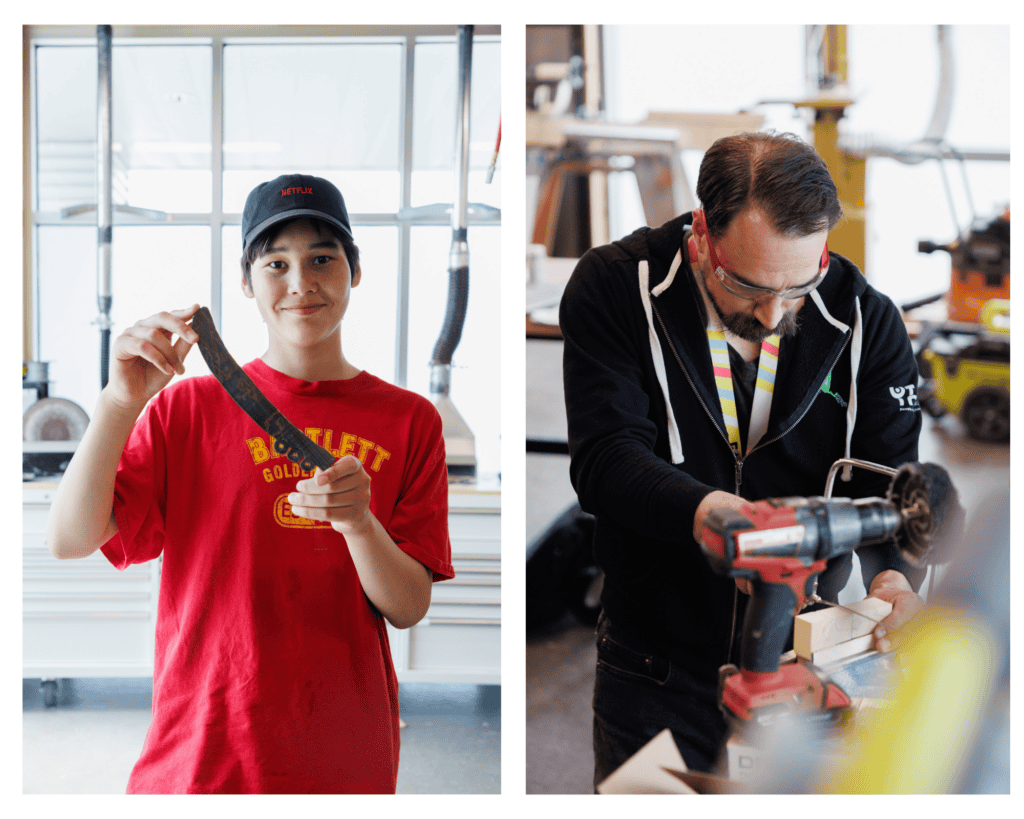22 Jul Learning from Our Ancestors
Students research and develop their own projects based on ancestral knowledge in CITC summer technology camp

Imagine a man or woman, native to our lands, traveling from thousands of years ago and arriving here, in Anchorage, at CITC’s Denełchin Lab, in 2024. This person would most certainly be astounded at everything surrounding them—laser printers, iPhones, computers, electricity.
But they would recognize the adze Benjamin Schleifman was fashioning on a sunny Monday afternoon this June.
“If my Tlingit ancestors were to see the adze that we produced here, they’d be like, Wow, that’s a really cool adze. Good job. Where’d you get those funny-looking woods?” the Fab Lab instructor commented.
He pointed out that the adze he was working on incorporates purple heart wood laminated with birch plywood, fiberglass, and resin—definitely not traditional materials that would have been used by his forefathers.

But that’s the point: In this summer’s Indigenous Water Technologies camp, high schoolers research the past and build upon it with modern tools.
“One of the things we’ve really focused on is becoming better academic students through identity work,” Benjamin said. “Whether you’re Tlingit, Haida, Dena’ina—it all comes down to our cultural identity, right? Sometimes you can find really significant science in somebody else’s culture. But it really does help to have that grounding presence in your life, thinking, wow, my ancestors accomplished this without these fancy tools.
“Most of our tools will be obsolete in a couple of years,” he went on. “But the kind of work we’ve been trying to do is priceless and timeless. The ability to manipulate metal by hand or build a structure from something you drew far outweighs anything that we’re going to teach with fancy equipment.”
The camp, which is a three-week intensive experience, gives students time to research, prototype, and develop a project of their own choosing. It’s a “deep dive” into each student’s ancestral knowledge.

One young person has been working on a bird bolo—a type of sling made of stones connected by a series of strings which can be thrown to knock out and capture a bird. Another student of Unangax descent is doing flint knapping, or shaping flint, chipping away at obsidian to create arrowheads. A third camper was given a piece of baleen and is creating their own storyknife, a tool used for sketching pictures on the ground or in the snow.
Rather than transferring the design they came up with from paper to baleen, this student laser engraved his original drawing with a machine in the Denełchin Fabrication Laboratory. Then he did additional carving to make his design “pop.”
In addition to working in the high-tech fab lab and woodshop at CITC’s Denełchin Lab, students took advantage of the weather and went on some outdoor adventures in the nearby Chugach Mountains. While students in previous technology camps explored rivers and oceans, this year’s campers have been focusing on the source of Anchorage’s water.

Back in the lab, they walk in the footsteps of their ancestors by taking what they’ve experienced and learned and building upon it to create.
“I always like to say that as Alaska Native people, we were masters of STEM before that acronym ever existed,” Benjamin said. “There’s just no way we could have thrived in these environments throughout the state without having mastery of science, technology, engineering, and mathematics.”
CITC has more camps coming up this summer! Visit our calendar to see additional camp opportunities.
Sign up for our Youth Education newsletter so you’ll never miss an opportunity to connect your kids and teens with fun, educational activities to supplement their school work or get them ready for the next phase of their lives.





